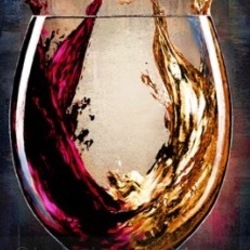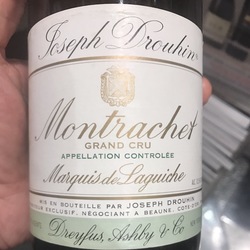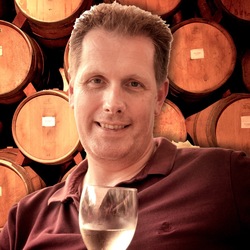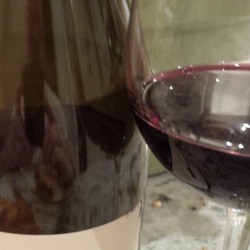Fallen Grape Wine Co.
Jorge Ordoñez & Co.
Rio Madre Rioja Graciano
Spanish Red Wine grape grown in Rioja. Harvested in October, aged well. — 6 years ago
The Dreaming Tree
North Coast Cabernet Sauvignon
Balanced Cabernet Sauvignon from Dave Matthews, light with grape flavor and low acid and tannin, at Dirty Water Pizza Co. In Back Bay, Boston — 6 years ago
Jorge Ordoñez & Co.
Botani Malaga Dry Muscat 2013
Cantaloupe, apple cider, sun flowers. A few years has given it a touch of baked fruit and pistachio. Medium body. Is it odd to have green leaves from plants that are not grape vines on the label? A simple, pretty wine. — 7 years ago
Château Brane-Cantenac
Grand Cru Classé en 1855 Margaux Red Bordeaux Blend 2005
I have a six-pack of this 05. I thought after 10 years in bottle, it would be interesting to check in on its evolution. While tasty, I’ll wait another 8-10 to open another. Even after 2-3 hours in the decanter, it’s still a very young adolescent. On the nose, slightly sour blackberries & dark cherries, dark currants, baked black plum, haunting blue fruits, anise, whiff of spice, steeped tea, dry stones, dry crushed rocks with dry top soil, caramel, vanilla with fresh & dry red florals. The body is thick & full. Tannins are starting to round out. It’s velvety on the palate. The fruits are; bright, fresh & ripe and really show the greatness of the 05 vintage. Dark currants, blackberries, dark cherries, baked black plum, haunting blue fruits, baked strawberries, cherries, raspberries on the long set, dark spice, clay & loamy dry top soil with crushed rocks, dry stones, cigar with ash, graphite, dry stems, slight herbaceous character, mint, used leather, clove, caramel, vanilla, fresh & dry red florals with violets. The round acidity is about perfect. The structure and length are still strong. The balance is in harmony. As for the long finish, it’s lush, ruby, rich and well polished. Photos of; Chateau Brane Cantenac, large wood vats, Henri Lurton and Estate vines. Producer notes and history...Chateau Brane Cantenac began in the early 17th century. At the time, the estate was known as Domaine Guilhem Hosten. Even that far back, wine was produced from the property. In fact, the wine was so highly regarded it was one of the more expensive wines in Bordeaux. It sold for almost as much money as Brane Mouton. This is interesting because of who went on to buy the vineyard in the 1800’s. The Baron of Brane, also known as “Napoleon of the Vineyards”, purchased the Chateau in 1833. At the time of the sale, the estate was called Chateau Gorce-Guy. To get the funds needed to purchase the Margaux vineyard, the Baron sold what is now called Mouton Rothschild, which was at the time of the sale, known as Chateau Brane-Mouton. Not such a good move with hundreds of years in hindsight! In 1838, the Baron renamed property taking his name and the name of the sector where the vineyards were located and called it Chateau Brane Cantenac. The Chateau later passed to the Roy family, who were well-known in the Margaux appellation in those days, as they owned Chateau d’issan. Moving ahead to 1920, the Societe des Grands Crus de France, a group of merchants and growers that owned several chateaux located in the Medoc including; Chateau Margaux, Chateau Giscours, and Chateau Lagrange in St. Julien, purchased Chateau Brane Cantenac. Five years later, M. Recapet and his son-in-law, François Lurton, took over Brane Cantenac along with Chateau Margaux. Lucien Lurton (the son of François Lurton) inherited Brane Cantenac in 1956. Today, the estate is still in the hands of the Lurton family. Brane Cantenac is owned and run by Henri Lurton. After being given the responsibility of managing Brane Cantenac, it was under the direction of Henri Lurton that large portions of the vineyard were replanted. Vine densities were increased, the drainage systems were improved and the plantings were also, slowly changed. The vineyard of Brane Cantenac is planted to 55% Cabernet Sauvignon, 40% Merlot, 4.5% Cabernet Franc and .5% Carmenere. Carmenere was used for the first time in the 2011 vintage. The only other Chateau I know that still uses Carmenere is Clerc Milon. The 75 hectare Left Bank vineyard of Brane Cantenac is essentially unchanged since it earned Second Growth status in the 1855 Classification. At least that is the case with the 45 hectares used to produce the Grand Vin of Brane Cantenac. Those 45 hectares are planted surrounding the Chateau. Those vines are located just in front of the Cantenac plateau and are the best terroir that Brane Cantenac owns. They have other parcels, which are further inland and much of those grapes are placed into their second wine, Le Baron de Brane. Those additional hectares can be divided into 3 main sections. Behind the Chateau, they have 15 hectares of vines on gravel and sand, 10 hectares across the road with sand, gravel and iron and a 13 hectare parcel with gravel called Notton, which is used for their second wine. The vineyard is planted to a vine density that ranges from 6,666 vines per hectare on the plateau and up to 8,000 vines per hectare for the vines located behind chateau, in their sandier soils. The higher levels of vine density are always found in the newer plantings. The terroir of Brane Cantenac consists of deep gravel, sand and clay soil. Experiments in the vineyards are currently looking at becoming more organic in their vineyard management. Today, more than 25% of Brane Cantenac is farmed using organic farming techniques. It is expected that over time, the amount of hectares farmed with organic methods will be increased. Brane Cantenac has gone through 2 relatively recent modernization’s in 1999, when they added began adding the first of their smaller vats to allow for parcel by parcel vinification and then again in 2015 when they completed a much more complete renovation of their cellars and vat rooms. While Brane Cantenac is a traditional producer, they are no stranger to technology as they were one of the first estates to embrace optical grape sorting machines. In very wet vintages, they can also use reverse osmosis. To produce the wine of Chateau Brane Cantenac, the wine is vinified in a combination of temperature controlled, traditional, 22 oak vats, 18 concrete tanks and 20 stainless steel vats that vary in size from 40 hectoliters all the way up to 200 hectoliters, which allows for parcel by parcel vinification. 40% of the fermentation takes place in the oak vats. The oldest vines are vinified in vats that are selected to allow for separate parcel by parcel vinification. The younger vines are vinified more often together in the same vats. However, the Carmenere is entirely micro-vinified, meaning that those grapes were completely vinified in barrel, using micro-vinification techniques. This can also happen because the amount of grapes produced is so small. Some vats can be co-inoculated, meaning they go through alcoholic fermentation and malolactic fermentation simultaneously. At Chateau Brane Cantenac, malolactic fermentation takes place in a combination of French oak tanks and barrels. The wine of Brane Cantenac is aged in an average of 60% new, French oak barrels for 18 months before bottling. The initial 2 months of aging is done with the wine on its lees, which adds more depth to the wine. There second wine is Le Baron de Brane. Le Baron de Brane is not new. In fact, previously, the second wine went under the name of Chateau Notton, which took its name from one of the main parcels where the grapes were planted. During the late 1950’s and into the 1960’s, having a second wine was important as the estate declassified 3 vintages, due to extremely poor, weather conditions in 1956, 1960 and 1963. Production of Chateau Brane Cantenac is about 11,000 cases per year. — 8 years ago

Foxen
Dry Farmed Tinaquaic Vineyard Chardonnay 2013
This dry farmed Chardonnay from Foxen was part of a shipment, and from a vineyard I always enjoy drinking. Rancho Tinaquaic was a land grant, from Mexico, given in 1837 in which the Tinaquaic vineyard resides. The vineyard is just northeast of Los Alamos. The land grant was purchased by Foxen co-owner Dick Doré's great great grandfather. The Foxen boys typically dry farm these grapes and sometimes the results can be magnificent (e.g. 2007 Cab Franc or 2012 Syrah). Great care must be taken with the dry farmed fruit - the right soil, microclimate, and maintenance - or the grower will be left more raisin than grape. Foxen is one of the few in Santa Barbara county that still practice the craft, and practice it well. ~$37 | #foxen #chardonnay #tinaquaic
On the eyes: Clear, star bright yellow, light stain, med+ tears, no gas/floc.
On the nose: Overripe pineapple, overripe pear, jasmine, and soft cheese with a touch of salty citrus. Med alcohol.
On the tongue: Med+ acid, med tannin, med alcohol, med+ body, buttery in the mouth. Tropical fruits, (think pineapple, guava, and lychee), rounded out with cashew and orange blossom. Nice finish. — 10 years ago
Marcassin
Marcassin Vineyard Pinot Noir 2010
Some friends of ours brought this to our backyard dinner last night. This is not a producer I buy. So, it was nice to revisit and nice of them to share.
The first thing I would say, is this is a well made Pinot Noir. Having said that, I don’t buy it due to its pricing. If you are buying this from the winery, its price point is still too high for it’s quality and gets worse yet when you go to the secondary markets which, many do, due to its limited production & wait on their list.
I say this because I have had countless examples of Sonoma & CA Pinot Noirs that are as good for $75 or around that price point give or take a little. The Hendricks Pinot from Santa Lucia is a similar style and for me, is better than this Marcassin. The Hendricks is $75 on futures buying.
Our friends that brought it, whom we share a mutual friendship with another Sommelier. He told them they had to drink this as it was getting old. I can tell you that is simply not the case. This wine has another 7-10 years of fine drinking ahead. These statements happen when your consuming wine regiment is based on a steady stream of always drinking wines young...It just happens.
The wine shows beautiful mid & dark candied, floral fruits, heavy baking spices and too much cinnamon stick for me. Beautiful, dark, red, blue and purple florals. It is well balanced, lush, elegant, polished with nice round acidity.
A very nice wine just overpriced IMHO. You can do just as well for less and you would only lose out on the fact you are feeling good about opening a cult name Pinot for yourself or to impress others. Not a dig, just the wine psychology that experience has led me to through the devotion of studying wine and consumers feedback. Not all, but enough to call it what it is. I myself have fallen prey to those emotions & I’m sure will again.
Photo of, Marciassin Winery, Helen Turley-Co Owner, Ryan O'Donnell-Winemaker and a Sonoma vineyard they source fruit. — 5 years ago
Bedrock Wine Co.
The Bedrock Heirloom Sonoma Valley Red Blend
19 grape varieties from 130 year old Bedrock estate vineyard. Buy all of this you can get your hands on. The 2016 was -#10 on Wine Spectators Top 100. I buy a case or two a year from Bedrock. Get on the allocation list and buy early! — 7 years ago
Jorge Ordoñez & Co.
#1 Selección Especial Málaga Moscatel 2006
Oxidized wine from Southern Spain and the Moscatel grape. Notes of peaches and oranges drenched in honey. Flavors of almonds and toffee. Unctuous texture and even a bit thick. Not overly sweet. Outstanding dessert wine. — 7 years ago
Cruse Wine Co.
Monkey Jacket North Coast Red Blend
Dad's birthday 2017 from urban grape — 8 years ago
Cruse Wine Co.
Ricci Vineyard St. Laurent
Bay Grape wine club. Smooth blend. Somewhat fruity but not overly so. Balanced sweetness. — 8 years ago
Domaine Jamet
Côte-Rôtie Syrah 2007
If there were ever an archetypical Syrah, Jamet's Cote-Rotie would be a strong candidate. To me this is a pure expression of a classic Northern Rhone Syrah. It is not a single site, but a blend of terroirs, encompassing over 20 sites mostly from hard rock schist bedrock with little to no topsoil. There is NO Viognier in this wine like one might expect from most Cote-Rotie that might have 1-5% co-fermented.
Importantly, there is also a lot less of the oak character that can dominate and overwhelm many Northern Rhone wines. The oak maturation, while not short at 22 months, only uses 15% new oak with no trace of it on the palate as it is perfectly integrated. Grape bunches are whole cluster fermented and macerated for up to 3 weeks.
The 2007 we have here was drinking superbly for a young wine, showing lively and racy layers of peppercorn spice, roast beef, and warm blackberry and currant fruit from the hot 2007 vintage. While from a warm vintage, not a hair is out of place. Density and purity exude from the nose and hint at what a brilliant future this wine has. Perfect acidity and fleshy ripe tannin provide the backbone structure for father time to peel back the layers of this beauty. I will be chceking back in 5 years at the earliest. — 9 years ago
Bedrock Wine Co.
Montecillo Vineyard Cabernet Sauvignon 2013
Dense purple red in color. Phenol, graphite, smoke, mint, black currant in nose. Mint-spearmint cherry-black currant cough syrup, vanilla, orange marmalade and black pepper in finish with grape seed bitterness and grape skin astringency. Could use at least two more years of aging. — 9 years ago
Azores Wine Co.
António Maçanita Isabella a Proibida 2016

La Chablisienne
La Fief de Grenouilles Chablis Grand Cru Chardonnay 2006
One of the absolute best white wines I’ve had so far this year to date was this extraordinary Grand Cru Chablis from 2006. I think we caught this wine at the absolute perfect time to drink. Grenouilles is French for frog, more on that below.
•
The color on this was perfect, a vibrant light gold and yellow, watery at the rim. The nose was also in perfect condition, notes of flint, crushed oyster shell, a touch of smoke, allied with fresh Asian pear and crisp Fuji apple. The wind absolutely jumped out of the glass, the nose was so pronounced. The palage took it another level up with a perfect expression of what the nose was giving, all the while wrapped up in a perfect medium bodied majorly dense and complex wine. Medium plus acidity and very long on the finish.
•
Formed in 1923, la Chablisienne is a co-op winery based of course in Chablis. As I have gone deeper into the rabbit hole of wine I tend to find these amazing co-ops which I wish I could have known about earlier as the wines are so impeccably good and priced so reasonably well. They produce something like 30 different wines off from the Chardonnay grape and all from vineyards within the AOC borders of Chablis.
•
The Grenouilles climat is the smallest of the 7 Chablis Grand Cru climat at 9.38 hectares. It has soils that consist of upper and middle layers of Kimmeridgian, alternating with limestone and marl that are studded with fossilised seashells.
•
The first vines to grow at the bottom of this hill were close to the River Serein and frogs no doubt came to keep the winegrowers company. — 6 years ago
Bedrock Wine Co.
Ode to Lulu California Old Vine Rosé Blend
It might shock you, but my favorite rosé is not French but instead comes from California! Blasphemy, I know - but Bedrock's Ode to Lulu is just that good. The difficulty is actually finding a bottle. For the last three years, I've only been allocated a case (or less) to sell here in Denver. It's possible you are one of the select few I've actually told about this wine... If not, now is your chance. This is the first year there's an "okay" supply. It won't last, but you should be able to get a bottle.
So yes, it's not French but it's made in the same style and method of Tempier Bandol Rosé- the most sought after, cult rosé out there. The name "Ode to Lulu" is actually an homage to the 4.5 foot tall, 101 year old woman named "Lulu" Peyraud (born Lucie Tempier) whose father gifted the Mourvedre heavy estate to her and her husband Lucien Peyraud. The wines they would go on to produce from the 1940's onward quite literally defined Bandol and put it on the map as some of the best rosés out there. She's still alive and presumably drinking plenty of wine.
This California-born "Ode to Lulu" is modeled after the great Tempier, but has some unique properties compared to it's French namesake. For one, the vines are EXTREMELY old. Tempier defined itself by focusing on old Mourvèdre and Grenache plantings, but even these French vineyards cannot compare to what Bedrock is working with in California. If you don't know, Bedrock is the winery of Morgon Twain Peterson, son of legendary Ravenswood founder Joel Peterson. Morgon grew up making wine and through his father has cultivated relationships with some of the most important heritage vineyards in California. The "Ode to Lulu" is made from Mourvèdre and Grenache planted as far back as 1888! These are some of the oldest plantings of these grapes around and make for unbelievable wines. Tempier's average vine age is around 40 years old today. Bedrock's is over 3x as old. Insane.
Morgon may be young, but he has a life time of winemaking experience. He started making wine with his father when he was 5 years old and hasn't stopped yet. In addition to absorbing his father's knowledge on heritage vineyards, he is a real student in the world of wine, earning a "Masters of Wine" designation (this industry's highest achievement). I've been drinking his wine for several years and I can say that his wine is made extremely thoughtfully and with expert attention to detail. This is true even with a wine as humble as rosé.
Unlike most California pink wine, Bedrock is not produced by "bleeding off" juice from a red wine. Instead, the grapes are picked early and separately at very low potential alcohols, and whole cluster pressed with low extraction. This preserves the freshness and acidity, creating a wine of clarity. In an old blog post I dug up, Morgon explains this idea:
"I pick at potential alcohols lower on the scale where brightness and lift still exist. This is not to say that fruit does not matter—I use Mourvedre from a block planted over 120 years ago for requisite concentration of complexity of flavor—but like fine champagne, the wonders of rosé lie in its unbearable lightness of being."
I agree with this idea of rosé and I think most people instinctively do as well. It's no coincidence that our best selling bottles come from provence. However, I urge you to pick up at least one bottle of this Ode to Lulu. It's a wine that's close in spirit to the best French rosé but made from vineyards that are American and unrivaled in age.
This is the fourth vintage of Ode to Lulu I've tasted, and I would say that's the most elegant yet. The 2015 was maybe my favorite for it's depth and I picked a few up to age, drinking my last bottle recently... This new vintage is great now, but it will reward with a short cellaring time. Honestly, if you can hide 2 bottles and drink them before fall or into next year, you will be blown away. Bandol rosé is a wine that improves dramatically over the course of 6 months to several years (Tempier Rosé is known to go decades). This bedrock is no different.
I can personally attest to past vintages gaining depth with time. How is this possible? Unlike other rosé which should be drank young, Bandol and Ode to Lulu are made of Mourvedre, a grape that is naturally reductive and resistant to oxidation. Further, the acidity is high and alcohol low. As the acidity starts to fall away, a depth and richness of character will emerge. In fruitier/riper rosé with more alcohol, this richness becomes too sweet and cloying... Not the case here. This keep balanced through time, gaining complexity while remaining refreshing.
You should buy this wine. However, I think there is one more important facet to rosé that I should mention before you do... Rosé is not always about what's in the glass itself. Rosé is really an ethereal thing... It's more so an "essence" of terroir and vintage rather than a sturdy, hard representation like red wine is... Sorry if that doesn't make sense but what I'm trying to say is that sometimes rosé is more about the place and the people you enjoy it with than the exact flavors themselves. Of course, we cannot all visit the picturesque village of Bandol to visit Lulu Peyraud; but I think, with this sunny Colorado weather, we can come close. Perhaps Morgon said it better than I can:
"Proper rosé is refreshing, life-nourishing stuff that revives the soul... I drink as much for pure pleasure as for intellectual stimulation. In the warmer months there is something sacred about a late afternoon meal of cold chicken, fresh garden tomatoes, and rosé. It is one body in the sacred trilogy of rustic simplicity." - Morgon Twain Peterson
#rose #oldvine #lulu #tempier #bedrockwineco — 7 years ago
Jorge Ordoñez & Co.
Zerran Montsant Garnacha Blend
40% Mazuelo grape attracted my attention as I knew little of this varietal. A beautiful enrichment if the garancha / Syrah backbone exposes the rich flavors of the region. Another fantastic selection of Jorge Ordonez! — 9 years ago
Pithon-Paillé
Mozaïk Anjou Chenin Blanc 2011
i won this wine in a card game against Jeremy Stoppelman, Yelp co-founder and CEO. He called me a motherfucker and threaten to kill my kids, but I won the card game fair and square.
thos wine is pretty good. What can I say, it's a grape wine, the very best. — 9 years ago
Bagg Dare Wine Co.
Well Hung White Blend
Grape flavors! Sweet. More dessert wine but enjoyable — 9 years ago













Gaurav Tiwari
Easy to drink Carneros Merlot vs their everyday Merlot that’s from Napa. It is cooler in Carneros and the grape can be harvested later giving it more fruit. And it shows..this had some age to it at this point, but still fruit forward. Soft tannins and good acidity. Spices like cinnamon and peppers in the finish potentially with the French oak aging. Well balanced wine and classic expression of new world Merlot. — 5 years ago